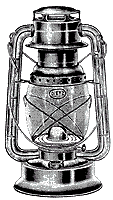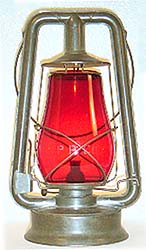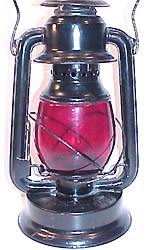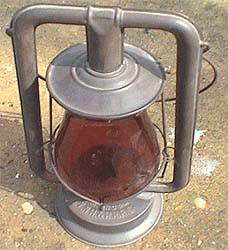|
|
Tubular "Barn-Style Lanterns
 Tubular lanterns are characterized by vertical tubes that flank the
globe, as shown by the illustration at right. Although one line of railroad
lanterns, the Dietz "Vesta",
used this design, the vast majority of tubular lanterns were manufactured
for general domestic, farm, and industrial purposes. There were many
variations on this general style using both the "hot
blast" and "cold blast" combustion
design. Many different manufacturers, including R.E. Dietz, Embury, and
C.T. Ham, produced tubular lanterns, and some production continues to
this day for domestic and specialty markets. Tubular lanterns are characterized by vertical tubes that flank the
globe, as shown by the illustration at right. Although one line of railroad
lanterns, the Dietz "Vesta",
used this design, the vast majority of tubular lanterns were manufactured
for general domestic, farm, and industrial purposes. There were many
variations on this general style using both the "hot
blast" and "cold blast" combustion
design. Many different manufacturers, including R.E. Dietz, Embury, and
C.T. Ham, produced tubular lanterns, and some production continues to
this day for domestic and specialty markets.
Tubular lanterns are frequently misidentified as railroad lanterns,
so much so that railroadiana collectors irreverently refer to them as "barn
lanterns". The reality is that railroad companies mostly used other
lantern styles specifically designed for this industry. Railroad operations
required a particular combination of reliability, durability, and portability
that led to the development of specialized lanterns with smaller globes
and, in some cases, different combustion properties. Collectors are therefore
advised to become familiar with railroad lantern styles, and be especially
wary of any claim that an unmarked tubular lantern is a "railroad" lantern.
That being said, some railroads, especially traction companies, did
use tubular "barn" lanterns. However, the consensus among collectors
is that such lanterns must be explicitly marked with the railroad or
traction company name to be considered authentic railroad artifacts.
Without such a marking, a given lantern could very easily (likely) have
been used for a farm, industrial, commercial, or domestic purpose with
no railroad connection whatsoever. See markings below.
Shown below are some examples of traction or railroad-marked tubular
lanterns. Note that all of these lanterns have red globes, which seems
to be rather typical for such lanterns in traction or railroad service.
What were they used for? G.A. Vandercook emailed us to suggest that they
probably were used to warn of construction or repair sites on street
railways. In other words they may have functioned somewhat like traffic
lanterns to warn people of hazards around such sites. There is some photographic
evidence to support this theory. Whatever their use, tubular lanterns
marked for traction or railroad companies are very collectible.
 |
 |
 |
| Above Left: A Supreme No. 210 made
by Embury and marked "P.R. CO," for the Pittsburgh Railways
Company, the operator of traction services in the Pittsburgh area
for many years. The lantern also has an etched globe with the same
marking. Above Center: A Little Supreme No. 150
made by Embury and marked "Property of The Cinti. St. Ry.Co." --
Cincinnati Street Railway Company. Photo courtesy of Bob Niblick. Above
Right: A Rayo #65 marked "NYNH&H RR Co" for the
New York, New Haven & Hartford Railroad, A.K.A. "New Haven".
Since the New Haven was a conventional steam railroad, this lantern
shows that such railroads did in fact use tubular "barn" lanterns,
although there are rather few known markings. |
Known Markings
Baltimore Traction (reportedy)
B.T. Co. (Dietz model)
Boston Elevated Railways
Boston Elev. (Dietz "Monarch" model)
Boston Elevated Ry. (Embury "#10 Supreme" model)
B.E. Ry. Co. (Prichard Strong "Prisco" model)
Cincinnatti Street Railway Company
Cinti. St. Ry. Co. (Embury #150 "Little Supreme" model)
Connecticut Company
Connecticut Company (Rayo model)
Detroit United Railway
D.U.R. (Buhl "Conquest" model)
Market Street Railway
M.S. Ry Co (Dietz Hi Lo)
New York, New Haven & Hartford Railroad
N.Y.N.H.& H. R.R. (Rayo #65 model)
N.Y.N.H.& H. R.R. Co. (Rayo #65 model)
NY.NH.& H R.R. (Rayo #75 model)
N.Y.N.H.& H. R.R. (Dietz model)
Old Colony Street Railway
O.C. St. Ry (Manufactured by Winfield)
Pennsylvania Railroad
{PRR in Keystone} * See note 1 below
Philadelphia Rapid Transit
Phila. Rapid Transit (Dietz "Victor" model)
Philadelphia Traction
P.T. CO. (Dietz model)
Pittsburgh Railways
P.R. CO. (Embury "#210 Supreme" model)
San Diego Electric Railway
SAN DIEGO ELECT. RAILWAY (Embury "#350 Little Supreme" model)
Springfield Street Railway
Spgfield. St. Ry. Co. (Rayo #65 model)
Tennessee Central Railway
T.C. Ry Co (Dietz Monarch)
Union Pacific Railroad
U.P. (Dietz "#2" model)
Footnotes:
- In a "hot blast" lantern, partially
heated air was mixed with fresh air to promote combustion. The hot
air was delivered to the flame by the flanking tubes. In a "cold
blast" lantern, only fresh, cold air was fed to the flame. This
type of combustion produced a brighter light than a comparably sized "hot
blast" lantern. See Anthony Hobson's book, cited below, for details
on the two combustion designs.
- There are reliable reports of a reproduction or fake Pennsylvania
Railroad "barn style" lantern, which one source says is made
of brass and looks newly made. However, there is a version with a PRR
keystone tag that is believed to be legitimate, or at least this is
the consensus among a number of collectors.
- The marking "DW&P" on a "barn style" lantern
most likely stands for Department of Water & Power, not Duluth,
Winnipeg & Pacific Railway. Both frames and globes (etched and
cast) are found with this marking, including blue globes. Just what
this stands for is unclear. Some collectors have suggested that "DW&P" was
a generic marking for "Department of Water & Power" and
applicable to many different utilities. But G.A. Vandercook emailed
us to suggest that it may simply refer to the Department of Water & Power
of the City of Los Angeles. He mentions that this was a large and respected
organization known by other municipal lighting experts as marking street
lamps etc. with "DW&P". He has further observed that
when lanterns with this marking have appeared in internet auctions,
most have come from Southern California. So "DW&P" may
not be a standard marking but specific to the City of Los Angeles Department
of Water & Power. Update: Summer '09: We received the following comment (edited): "I found a "No 210 Supreme" Lantern at my Father-in-Law's house a few years ago. It has a red lens with "DW&P" cast into the lens and "D.W.&P." on the base of the lantern. I thought it was a railroad lantern until I read an article on your web site named "Tubular Barn-Style Lanterns". My Father In-Law lived in Big Bear California at the time I acquired the lantern, and had lived in various places in southern Cal. over the years. Since it came from So Cal it lends credence to the idea that "DW&P" means Los Angeles Dept of Water & Power." [Thanks to RH] Update: Fall '19: We received the following comment (edited): "I was on your site trying to ID a Dietz No 210 that I received some 50 years ago while living in the San Fernando Valley, just north of Los Angeles proper. My lantern is embossed on the fill side of the font "NO 210 SUPREME", the other side is embossed "D. W. & P.". The lantern's red globe or mantel is embossed CITY OF LA, within a rectangle. Therefore I would think that, at least in the case of my lantern, it was made by Dietz specifically for the Los Angeles, Department of Water and Power." [Thanks to JS]
- Globes: The listings on this page concern markings on lantern frames,
but there are also marked globes that fit these types of lanterns.
Markings to date: "P.R. Co." {red etched); IRC" {clear
cast for International Railway Company}; PRR keystone logo; "NYC
Lines" (fits a C.T. Ham No 0 "Clipper" tubular lantern;
P.R.T.Co. (Philadelphia Rapid Transit); U.P. blue globe. Also,
see Note 2 above.
- Although reliable sources have been used for markings, this list
may contain errors. No guarantee is given with regard to
accuracy.
- To contribute new markings, please give the exact marking, including
periods. Also, please include information on manufacturer and
model number, if available. Email
us via the Contact Us page with this information. Thanks to contributors of new
markings.
- All markings that are contributed are confidential, and ownership
information will not be disclosed under any circumstances. Thanks to everyone who has sent in markings!
Sources:
Hobson, Anthony. Lanterns that Lit our World: How to Identify,
Date, and Restore Old Railroad, Marine, Fire, Carriage, Farm, and Other
Lanterns. (Published: 1993). Golden Hill Press, Spencertown,
NY 12165. |